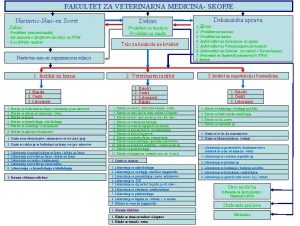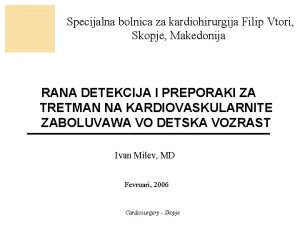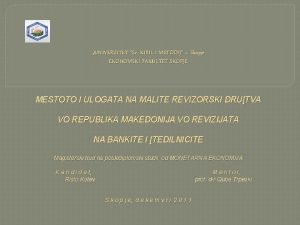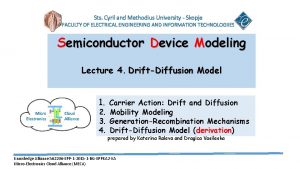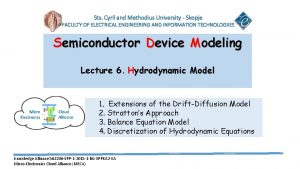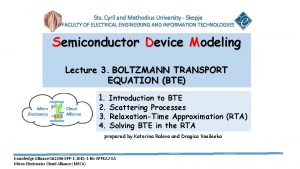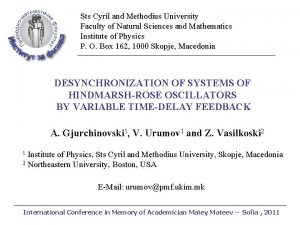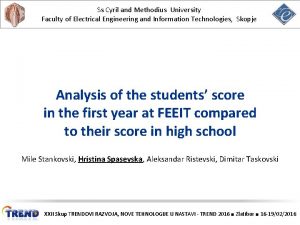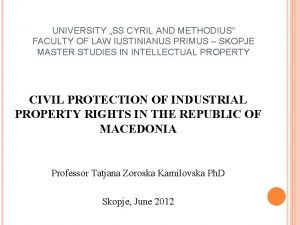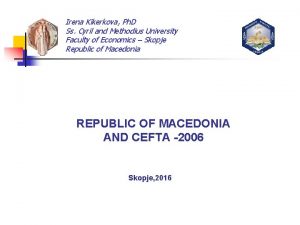Sts Cyril and Methodius University Skopje FACULTY OF






![Approximate Solution for PDE – Discretization Finite Difference Method [5] How good are the Approximate Solution for PDE – Discretization Finite Difference Method [5] How good are the](https://slidetodoc.com/presentation_image_h/c96c5b65cf0447f0815892a2bde4247b/image-7.jpg)
![Approximate Solution for PDE – Discretization Finite Difference Method [6] - Taylor Series (with Approximate Solution for PDE – Discretization Finite Difference Method [6] - Taylor Series (with](https://slidetodoc.com/presentation_image_h/c96c5b65cf0447f0815892a2bde4247b/image-8.jpg)
![Approximate Solution for PDE – Discretization Finite Difference Method [7] - Taylor Series (with Approximate Solution for PDE – Discretization Finite Difference Method [7] - Taylor Series (with](https://slidetodoc.com/presentation_image_h/c96c5b65cf0447f0815892a2bde4247b/image-9.jpg)

![Approximate Solution for PDE – Discretization Finite Difference Method [9] Second Derivative (cont’d) where Approximate Solution for PDE – Discretization Finite Difference Method [9] Second Derivative (cont’d) where](https://slidetodoc.com/presentation_image_h/c96c5b65cf0447f0815892a2bde4247b/image-11.jpg)



![Approximate Solution for PDE – Poisson Equation [1] STEP 1: Linearization of the Poisson Approximate Solution for PDE – Poisson Equation [1] STEP 1: Linearization of the Poisson](https://slidetodoc.com/presentation_image_h/c96c5b65cf0447f0815892a2bde4247b/image-15.jpg)
![Approximate Solution for PDE – Poisson Equation [2] STEP 1: Linearization of the Poisson Approximate Solution for PDE – Poisson Equation [2] STEP 1: Linearization of the Poisson](https://slidetodoc.com/presentation_image_h/c96c5b65cf0447f0815892a2bde4247b/image-16.jpg)
![Approximate Solution for PDE – Poisson Equation [3] STEP 1: Linearization of the Poisson Approximate Solution for PDE – Poisson Equation [3] STEP 1: Linearization of the Poisson](https://slidetodoc.com/presentation_image_h/c96c5b65cf0447f0815892a2bde4247b/image-17.jpg)
![Approximate Solution for PDE – Poisson Equation [4] STEP 1: Linearization of the Poisson Approximate Solution for PDE – Poisson Equation [4] STEP 1: Linearization of the Poisson](https://slidetodoc.com/presentation_image_h/c96c5b65cf0447f0815892a2bde4247b/image-18.jpg)
![Approximate Solution for PDE – Poisson Equation [5] STEP 2: Discretization of the linearized Approximate Solution for PDE – Poisson Equation [5] STEP 2: Discretization of the linearized](https://slidetodoc.com/presentation_image_h/c96c5b65cf0447f0815892a2bde4247b/image-19.jpg)
![Approximate Solution for PDE – Poisson Equation [6] STEP 3: Boundary Conditions for the Approximate Solution for PDE – Poisson Equation [6] STEP 3: Boundary Conditions for the](https://slidetodoc.com/presentation_image_h/c96c5b65cf0447f0815892a2bde4247b/image-20.jpg)
![Approximate Solution for PDE – Poisson Equation [7] STEP 3: Boundary Conditions for the Approximate Solution for PDE – Poisson Equation [7] STEP 3: Boundary Conditions for the](https://slidetodoc.com/presentation_image_h/c96c5b65cf0447f0815892a2bde4247b/image-21.jpg)
![Approximate Solution for PDE – Poisson Equation [8] STEP 3: Boundary Conditions for the Approximate Solution for PDE – Poisson Equation [8] STEP 3: Boundary Conditions for the](https://slidetodoc.com/presentation_image_h/c96c5b65cf0447f0815892a2bde4247b/image-22.jpg)
![Approximate Solution for PDE – Poisson Equation [9] 1 D, Finite-Difference Discretization of the Approximate Solution for PDE – Poisson Equation [9] 1 D, Finite-Difference Discretization of the](https://slidetodoc.com/presentation_image_h/c96c5b65cf0447f0815892a2bde4247b/image-23.jpg)
![Approximate Solution for PDE – Poisson Equation [10] 2 D, Finite-Difference Discretization of the Approximate Solution for PDE – Poisson Equation [10] 2 D, Finite-Difference Discretization of the](https://slidetodoc.com/presentation_image_h/c96c5b65cf0447f0815892a2bde4247b/image-24.jpg)
![Approximate Solution for PDE – Poisson Equation [11] 2 D, Finite-Difference Discretization of the Approximate Solution for PDE – Poisson Equation [11] 2 D, Finite-Difference Discretization of the](https://slidetodoc.com/presentation_image_h/c96c5b65cf0447f0815892a2bde4247b/image-25.jpg)




















- Slides: 45

Sts. Cyril and Methodius University - Skopje FACULTY OF ELECTRICAL ENGINEERING AND INFORMATION TECHNOLOGIIES Semiconductor Device Modeling Lecture 5. Drift-Diffusion Equations NUMERICAL SOLUTION 1. Gummel’s Iteration Method 2. Newton’s Method 3. Time-Dependent Simulation 4. Scharfetter-Gummel Approximation prepared by Katerina Raleva and Dragica Vasileska Knowledge Alliance 562206 -EPP-1 -2015 -1 -BG-EPPKA 2 -KA Micro-Electronics Cloud Alliance (MECA)

Drift Diffusion Equations Poisson Equation Continuity Equations Current Density Equations

Approximate Solution for PDE Governing Equations ICS/BCS Discretization • • • Finite-Difference Finite-Volume Finite-Element Spectral Boundary Element Hybrid [1] Matrix Equation Solver System of algebraic equations Discrete Nodal Values • • • Tridiagonal SOR Gauss-Seidel Krylov Multigrid Approximate Solution φi (x, y, z, t) potential pi(x, y, z, t) – hole densiity ni(x, y, z, t)electron density

Approximate Solution for PDE – Discretization 1 2 3 Finite differences Finite volumes Finite elements [2] - time-dependent PDEs - Maxwell’s equations robust, simple concept, easy to parallelize, regular grids, explicit method - time-dependent PDEs robust, simple concept, irregular grids, explicit method - static and time-dependent PDEs - all problems implicit approach, matrix inversion, well founded, irregular grids, more complex algorithms, engineering problems

Approximate Solution for PDE – Discretization Finite Difference Method Common definitions of the derivative of f(x): These are all correct definitions in the limit dx 0. But we want dx to remain FINITE [3]

Approximate Solution for PDE – Discretization Finite Difference Method The equivalent approximations of the derivatives are: forward difference backward difference centered difference [4]
![Approximate Solution for PDE Discretization Finite Difference Method 5 How good are the Approximate Solution for PDE – Discretization Finite Difference Method [5] How good are the](https://slidetodoc.com/presentation_image_h/c96c5b65cf0447f0815892a2bde4247b/image-7.jpg)
Approximate Solution for PDE – Discretization Finite Difference Method [5] How good are the FD approximations? Taylor series are expansions of a function f(x) for some finite distance dx to f(x+dx): What happens, if we use this expression for ? . . . that leads to :
![Approximate Solution for PDE Discretization Finite Difference Method 6 Taylor Series with Approximate Solution for PDE – Discretization Finite Difference Method [6] - Taylor Series (with](https://slidetodoc.com/presentation_image_h/c96c5b65cf0447f0815892a2bde4247b/image-8.jpg)
Approximate Solution for PDE – Discretization Finite Difference Method [6] - Taylor Series (with forward formulation) The error of the first derivative using the forward formulation is of order dx.
![Approximate Solution for PDE Discretization Finite Difference Method 7 Taylor Series with Approximate Solution for PDE – Discretization Finite Difference Method [7] - Taylor Series (with](https://slidetodoc.com/presentation_image_h/c96c5b65cf0447f0815892a2bde4247b/image-9.jpg)
Approximate Solution for PDE – Discretization Finite Difference Method [7] - Taylor Series (with centered formulation) . . . with the centered formulation we get: The error of the first derivative using the centered approximation is of order dx 2. This is an important results: it DOES matter which formulation we use. The centered scheme is more accurate! accurate

Approximate Solution for PDE – Discretization Finite Difference Method Second Derivative According to the well-known expansion, and Upon adding these expansions, [8]
![Approximate Solution for PDE Discretization Finite Difference Method 9 Second Derivative contd where Approximate Solution for PDE – Discretization Finite Difference Method [9] Second Derivative (cont’d) where](https://slidetodoc.com/presentation_image_h/c96c5b65cf0447f0815892a2bde4247b/image-11.jpg)
Approximate Solution for PDE – Discretization Finite Difference Method [9] Second Derivative (cont’d) where O( x)4 is the error introduced by truncating the series. We say that this error is of the order ( x)4 or simply O( x)4. Therefore, O( x)4 represents terms that are not greater than ( x)4. Assuming that these terms are negligible,

Approximate Solution for PDE – Discretization Finite Difference Method FIRST DERIVATIVE SECOND DERIVATIVE Summary of Results [10]

Approximate Solution for PDE – Discretization Finite Difference Method - APPLICATION Application of Finite Difference Method to the Solution of: - 1 D Poisson Equation - 1 D Continuity Equation [11]

Approximate Solution for PDE – Poisson Equation How to solve it? STEP 1: LINEARIZATION STEP 2: DISCRETIZATION STEP 3: STEP 4: One has to apply proper boundary conditions: -Dirichlet vs Neumann -Treatment of the Ohmic Contacts Needs to be solved numerically: -Direct Methods -Iterative Methods for Solution of Sparse Matrix Problem
![Approximate Solution for PDE Poisson Equation 1 STEP 1 Linearization of the Poisson Approximate Solution for PDE – Poisson Equation [1] STEP 1: Linearization of the Poisson](https://slidetodoc.com/presentation_image_h/c96c5b65cf0447f0815892a2bde4247b/image-15.jpg)
Approximate Solution for PDE – Poisson Equation [1] STEP 1: Linearization of the Poisson Equation The 1 D Poisson equation is of the form:
![Approximate Solution for PDE Poisson Equation 2 STEP 1 Linearization of the Poisson Approximate Solution for PDE – Poisson Equation [2] STEP 1: Linearization of the Poisson](https://slidetodoc.com/presentation_image_h/c96c5b65cf0447f0815892a2bde4247b/image-16.jpg)
Approximate Solution for PDE – Poisson Equation [2] STEP 1: Linearization of the Poisson Equation (cont’d) [1] What are we solving for? Ec EF Ei Ev
![Approximate Solution for PDE Poisson Equation 3 STEP 1 Linearization of the Poisson Approximate Solution for PDE – Poisson Equation [3] STEP 1: Linearization of the Poisson](https://slidetodoc.com/presentation_image_h/c96c5b65cf0447f0815892a2bde4247b/image-17.jpg)
Approximate Solution for PDE – Poisson Equation [3] STEP 1: Linearization of the Poisson Equation (cont’d) [3] Define: φnew => φold + d
![Approximate Solution for PDE Poisson Equation 4 STEP 1 Linearization of the Poisson Approximate Solution for PDE – Poisson Equation [4] STEP 1: Linearization of the Poisson](https://slidetodoc.com/presentation_image_h/c96c5b65cf0447f0815892a2bde4247b/image-18.jpg)
Approximate Solution for PDE – Poisson Equation [4] STEP 1: Linearization of the Poisson Equation (cont’d) [4] Renormalized Form: LD=sqrt(qni/εVT)
![Approximate Solution for PDE Poisson Equation 5 STEP 2 Discretization of the linearized Approximate Solution for PDE – Poisson Equation [5] STEP 2: Discretization of the linearized](https://slidetodoc.com/presentation_image_h/c96c5b65cf0447f0815892a2bde4247b/image-19.jpg)
Approximate Solution for PDE – Poisson Equation [5] STEP 2: Discretization of the linearized Poisson Equation Finite Difference Representation Equilibrium: n and p calculated using appropriate transport kernel. Non-Equilibrium: (In DD model n and p are solutions of the corresponding continuity equations).
![Approximate Solution for PDE Poisson Equation 6 STEP 3 Boundary Conditions for the Approximate Solution for PDE – Poisson Equation [6] STEP 3: Boundary Conditions for the](https://slidetodoc.com/presentation_image_h/c96c5b65cf0447f0815892a2bde4247b/image-20.jpg)
Approximate Solution for PDE – Poisson Equation [6] STEP 3: Boundary Conditions for the Poisson Equation • Dirichlet Boundary Conditions at the Ohmic Contacts • Neumann Boundary Conditions at the artificial boundaries
![Approximate Solution for PDE Poisson Equation 7 STEP 3 Boundary Conditions for the Approximate Solution for PDE – Poisson Equation [7] STEP 3: Boundary Conditions for the](https://slidetodoc.com/presentation_image_h/c96c5b65cf0447f0815892a2bde4247b/image-21.jpg)
Approximate Solution for PDE – Poisson Equation [7] STEP 3: Boundary Conditions for the Poisson Equation (cont’d) [1] Dirichlet Boundary Conditions at the Ohmic Contacts • a 5 = 0 • b 5 = 1 • c 5 = 0 • f 5 = build-in + Vapplied
![Approximate Solution for PDE Poisson Equation 8 STEP 3 Boundary Conditions for the Approximate Solution for PDE – Poisson Equation [8] STEP 3: Boundary Conditions for the](https://slidetodoc.com/presentation_image_h/c96c5b65cf0447f0815892a2bde4247b/image-22.jpg)
Approximate Solution for PDE – Poisson Equation [8] STEP 3: Boundary Conditions for the Poisson Equation (cont’d) [1] Neumann Boundary Conditions at Artificial Boundaries • a 0 = 0 • c 0 = 2 c 0
![Approximate Solution for PDE Poisson Equation 9 1 D FiniteDifference Discretization of the Approximate Solution for PDE – Poisson Equation [9] 1 D, Finite-Difference Discretization of the](https://slidetodoc.com/presentation_image_h/c96c5b65cf0447f0815892a2bde4247b/image-23.jpg)
Approximate Solution for PDE – Poisson Equation [9] 1 D, Finite-Difference Discretization of the Poisson Equation - Example The resultant finite difference equations can be represented in a matrix form A∙u=f, where: A=
![Approximate Solution for PDE Poisson Equation 10 2 D FiniteDifference Discretization of the Approximate Solution for PDE – Poisson Equation [10] 2 D, Finite-Difference Discretization of the](https://slidetodoc.com/presentation_image_h/c96c5b65cf0447f0815892a2bde4247b/image-24.jpg)
Approximate Solution for PDE – Poisson Equation [10] 2 D, Finite-Difference Discretization of the Poisson Equation - Example In 2 D, finite-difference discretization of the Poisson equation leads to a FIVE POINT STENCIL:
![Approximate Solution for PDE Poisson Equation 11 2 D FiniteDifference Discretization of the Approximate Solution for PDE – Poisson Equation [11] 2 D, Finite-Difference Discretization of the](https://slidetodoc.com/presentation_image_h/c96c5b65cf0447f0815892a2bde4247b/image-25.jpg)
Approximate Solution for PDE – Poisson Equation [11] 2 D, Finite-Difference Discretization of the Poisson Equation – Example (cont’d)

Approximate Solution for PDE – Continuity Equations • Have to be discretized properly • Have to apply proper boundary conditions • Have to be solved numerically using: • Direct methods • Iterative methods for sparse matrices

Scharfetter - Gummel Discretization of the Continuity Equation Assumptions: • Electron density varies exponentially between node points • Proper calculation of the Bernoulli function is essential function Ber = berfun(x) flag_sum = 0; if(x>1 e-10) Ber = x*exp(-x)/(1 -exp(-x)); elseif(x < abs(x) > 1 e-10) Ber = x/(exp(x)-1); elseif(x == 0) Ber = 1; else temp_term = 1; sum = temp_term; i = 0; while(~flag_sum) i = i + 1; temp_term = temp_term*x/(i+1); if( abs(temp_term) < 1 e-14) flag_sum = 1; else sum = sum + temp_term; end Ber = 1/sum; end

Sharfetter - Gummel Discretized Continuity Equations

Approximate Solution for PDE – Continuity Equations Boundary Conditions for the Charge Density • At the ohmic contacts, charge neutrality is assumed at the boundaries: p - n + ND – NA = 0 and np = ni 2 • an 5 = ap 5 = 0 • bn 5 = bp 5 = 1 • cn 5 = cp 5 = 0 • Gn 5 = n 0, Gp 5 = p 0

Components of numerical methods (Solution of linear equation systems, introduction) • The result of the discretization using either Finite-Difference or Finite-Volume, is a system of algebraic equations, which are linear or non-linear • For non-linear case, the system must be solved using iterative methods, i. e. initial guess iterate converged results obtained. • The matrices derived from partial differential equations are always sparse with the non-zero elements of the matrices lie on a small number of well-defined diagonals.

LU Decomposition Method

Solution Methodology Flow-Charts: Equilibrium Solver Criterion for Convergence There are several criteria for the convergence of the iterative procedure when solving the Poisson equation, but the simplest one is that nowhere on the mesh the absolute value of the potential update is larger than 1 E-5 V. This criterion has shown to be sufficient for all device simulations that have been performed within the Computational Electronics community.

Solving the Coupled Set of Equations • Gummel’s Scheme • Solves the constitutive equations in a sequential manner. • Good for small coupling between the equations – low bias conditions. • Densities in the generation/recombination processes included in the model are updated after one Gummel cycle is complete which comprises one solution of the Poisson and one solution of the electron and hole continuity equations in a sequential manner.

Solving the Coupled Set of Equations (cont’d) • Newton Method • Solves all constituent equations simultaneously • Must be used when the equation set is strongly coupled • Gummel-Newton method - sometimes is the strategy to go • When convergence is poor, it is useful to get a good initial guess for the Newton solver by performing several Gummel cycles

Gummel’s Method Gummel’s relaxation method, which solves the equations with the decoupled procedure, is used in the case of weak coupling: • Low current densities (leakage currents, subthreshold regime), where the concentration dependent diffusion term in the current continuity equation is dominant. • The electric field strength is lower than the avalanche threshold, so that the generation term is independent of V. • The mobility is nearly independent of E. The computational cost of the Gummel’s iteration is one matrix solution for each carrier type plus one iterative solution for the linearization of the Poisson Equation.

Gummel’s Method (cont’d)

Newton’s Method • The three equations that constitute the DD model, written in residual form are: • Starting from an initial guess, the corrections are calculated by solving:

Newton’s Method (cont’d)

Solution Methodology Flow-Charts: Non-Equilibrium solver

COMPUTEL

COMPUTEL

COMPUTEL 42

COMPUTEL 43

COMPUTEL 44

In which devices Drift-Diffusion Model can be used? • DD Model is good for devices operated at relatively small biases (up to velocity saturation in the channel). Solar cells, long channel MOSFETs, low-power devices • DD Model fails in nanoscale and high-power devices in which velocity overshoot plays significant role: Nano-transistors in which ballistic transport dominates the device behavior, high power devices
 Faculty of business and economics mendel university in brno
Faculty of business and economics mendel university in brno Elearningunideb
Elearningunideb Faculty of business and economics mendel university in brno
Faculty of business and economics mendel university in brno Miokard
Miokard Università san cirillo e metodio skopje
Università san cirillo e metodio skopje Jsp bus
Jsp bus Veterinaren fakultet skopje
Veterinaren fakultet skopje Kardiohirurgija skopje
Kardiohirurgija skopje Fakultet za psihologija skopje
Fakultet za psihologija skopje Ekonomski fakultet skopje
Ekonomski fakultet skopje Osiguritelni kompanii
Osiguritelni kompanii Bioshield skopje
Bioshield skopje Mimoza ristova
Mimoza ristova Dif fakultet skopje
Dif fakultet skopje Bereket skopje
Bereket skopje Sv kiril i metodij skopje
Sv kiril i metodij skopje University of split faculty of maritime studies
University of split faculty of maritime studies University of bridgeport engineering
University of bridgeport engineering Bridgeport university computer science
Bridgeport university computer science Hubert kairuki memorial university faculty of medicine
Hubert kairuki memorial university faculty of medicine Semmelweis
Semmelweis King abdulaziz university faculty of medicine
King abdulaziz university faculty of medicine Fsu computer science department
Fsu computer science department Singularity executive program
Singularity executive program Agnes csaki semmelweis
Agnes csaki semmelweis Masaryk university medical faculty
Masaryk university medical faculty Feup university of porto
Feup university of porto Webkredit cuni
Webkredit cuni Faculty of veterinary medicine cairo university logo
Faculty of veterinary medicine cairo university logo Faculty of law of the university of zagreb
Faculty of law of the university of zagreb University of montenegro faculty of law
University of montenegro faculty of law University of kragujevac faculty of technical sciences
University of kragujevac faculty of technical sciences University of cologne faculty of management
University of cologne faculty of management Leading university founder
Leading university founder Hacettepe university faculty of medicine
Hacettepe university faculty of medicine Brown university computer science faculty
Brown university computer science faculty Conus arteriosus
Conus arteriosus Semmelweis university faculty of medicine
Semmelweis university faculty of medicine Lebanese university faculty of engineering
Lebanese university faculty of engineering York concurrent education acceptance rate
York concurrent education acceptance rate Ece clemson
Ece clemson Faculty of veterinary medicine cairo university
Faculty of veterinary medicine cairo university Faculty of mechanical engineering thammasat university
Faculty of mechanical engineering thammasat university Masaryk university medical faculty
Masaryk university medical faculty Slidetodoc.com
Slidetodoc.com Thin and thick smear
Thin and thick smear






